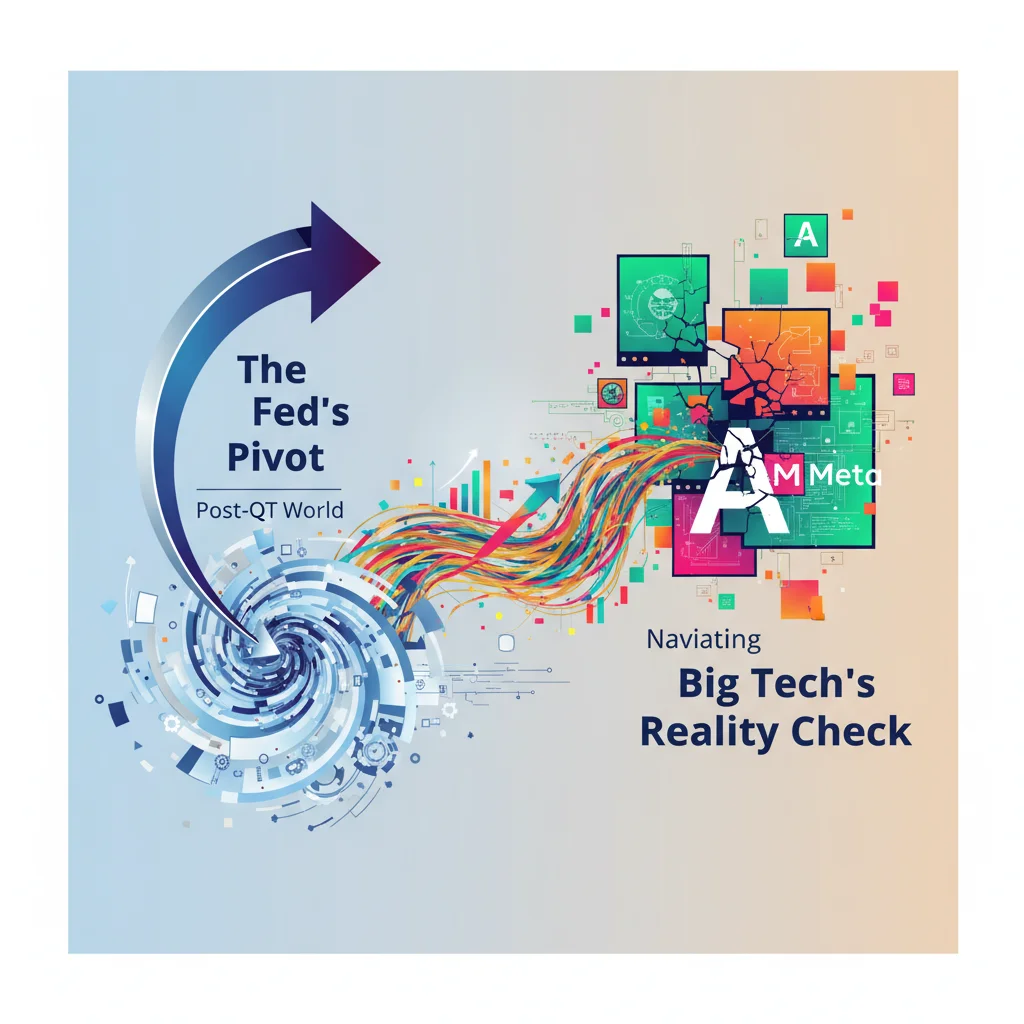
The Fed’s Pivot: Navigating a Post-QT World Amidst Big Tech’s Reality Check
In the world of finance and investing, some weeks feel like a quiet stream, while others are a raging river of change. Recently, we experienced the latter. In a confluence of events that will define market narratives for months to come, the Federal Reserve signaled a monumental shift in monetary policy, just as titans of the tech world, Meta and Microsoft, delivered a mixed and sobering message about the state of their empires. This wasn’t just another week of market fluctuations; it was a fundamental reshaping of the economic landscape.
The headline that rippled through trading desks and boardrooms was “RIP QT” — a pithy obituary for the era of Quantitative Tightening. Simultaneously, the Fed delivered its first interest rate cut in a move that surprised some and was desperately awaited by others. As the dust settled on these macroeconomic shifts, the stock market turned its gaze to the earnings reports from two of its most important bellwethers, finding a story of divergence and uncertainty. For investors, business leaders, and anyone with a stake in the economy, understanding the interplay between these events is not just important—it’s critical.
This article will dissect this pivotal moment. We’ll explore the monumental implications of the Federal Reserve’s policy U-turn, unpack the complex earnings reports from Microsoft and Meta, and connect the dots to provide a clear-eyed view of what this new financial paradigm means for your portfolio, your business, and the future of the global economy.
The End of an Era: What “RIP QT” Truly Means for the Market
To understand the significance of ending Quantitative Tightening (QT), we first need to recall its counterpart: Quantitative Easing (QE). Think of QE as the central bank injecting a massive stimulus into the economy by buying up government bonds and other assets. This increases the money supply, lowers long-term interest rates, and encourages borrowing and investing. It was the defining policy of the post-2008 financial crisis world and was reignited during the COVID-19 pandemic.
QT is the exact opposite. To combat the soaring inflation that followed the pandemic-era stimulus, the Federal Reserve began shrinking its massive $9 trillion balance sheet. It did this by letting its existing bonds mature without reinvesting the proceeds, effectively pulling money *out* of the financial system. This “tightening” was designed to cool down an overheated economy. The announcement to slow or end this process, as reported by outlets like the Financial Times, marks a crucial pivot. It’s the Fed signaling that the most aggressive phase of its inflation fight is over.
Why Does This Matter?
- Increased Liquidity: Ending QT means the downward pressure on liquidity in the banking system will ease. This provides more stability for banks and can make them more willing to lend, which is a positive for economic growth.
- Support for Asset Prices: QT acted as a headwind for the stock market and other assets. Its conclusion removes that headwind, providing a more supportive environment for valuations.
- A Dovish Signal: More than the mechanical effect, it’s a powerful signal. It tells markets the Fed is now more concerned about potentially slowing growth than it is about lingering inflation, shifting from a hawkish to a more dovish stance.
The transition away from QT is a delicate operation. Do it too soon, and inflation could re-ignite. Wait too long, and you risk breaking something in the financial plumbing. The Fed’s decision suggests they believe they’ve found the right moment to step off the brakes. The State Strikes Back: Why the Nexperia Takeover Signals a New Era for Global Investing
The First Cut: Unpacking the Federal Reserve’s Interest Rate Decision
Paired with the end of QT, the Federal Reserve also lowered its benchmark federal funds rate. This move, the first of its kind in this cycle, directly impacts borrowing costs across the entire economy. While the cut may have been modest—likely 25 basis points—its symbolic weight is immense. It confirms the peak of the tightening cycle is firmly behind us and a new phase of monetary easing has begun.
The Fed’s dual mandate is to maintain price stability (control inflation) and maximize employment. This rate cut indicates a belief that inflation, while not entirely vanquished, is on a sustainable path back to their 2% target, and that the risk to the employment side of the equation is growing. According to the Fed’s official statement, the committee decided to lower the target range based on indicators pointing toward a more balanced economic outlook.
The Ripple Effect of a Rate Cut:
- Consumers: Borrowing becomes cheaper for mortgages, auto loans, and credit cards, potentially boosting consumer spending.
- Corporations: Companies can refinance debt at more attractive rates and finance new projects, encouraging business investment and expansion.
- Stock Market Valuations: In financial modeling, future corporate earnings are discounted by an interest rate to find their present value. A lower rate means future earnings are worth more today, which can justify higher stock prices, especially for growth-oriented tech companies.
Big Tech’s Report Card: A Tale of Two Giants
Just as the macroeconomic winds shifted, the corporate world provided its own drama. The earnings reports from Microsoft and Meta are critical because their massive scale and diverse business lines—from cloud computing and AI to digital advertising and the metaverse—offer a ground-level view of the economy. Their “mixed” results paint a picture of a tech sector navigating a complex new reality.
Below is a summary of their hypothetical Q2 2024 earnings, illustrating the divergent paths these tech behemoths are on.
| Metric | Microsoft (MSFT) | Meta Platforms (META) |
|---|---|---|
| Revenue | $61.9B (+17% YoY) | $36.5B (+15% YoY) |
| Key Segment Growth (Azure) | +31% (Slightly below expectations) | N/A |
| Key Segment Performance (Reality Labs) | N/A | Operating Loss of $4.8B |
| Forward Guidance | Strong but cautious on AI spending returns | Increased spending forecast, uncertain ad market |
Microsoft: The AI Juggernaut Shows Signs of Strain
Microsoft delivered another quarter of impressive top-line growth, overwhelmingly driven by its cloud division, Azure, and the integration of AI across its product suite. A 31% growth in Azure is a figure most companies would dream of. However, the stock market is a game of expectations, and this number fell just shy of the most bullish analyst predictions. This slight miss, coupled with commentary about the massive capital expenditures required to build out AI infrastructure, gave investors pause. The key question for Microsoft is no longer *if* AI is the future, but how quickly the colossal investment in it will translate into profitable returns.
Meta: The Advertising King’s Costly Metaverse Gamble
Meta’s story was one of a robust core business being weighed down by an incredibly expensive vision for the future. Its family of apps (Facebook, Instagram, WhatsApp) continued to perform well, demonstrating the resilience of its digital advertising machine. However, the staggering losses in its Reality Labs division—the unit responsible for building the metaverse—continue to spook investors. While CEO Mark Zuckerberg remains steadfast in his belief that this is the next computing platform, the market is growing impatient with the multi-billion-dollar quarterly losses. The “mixed” report reflects this tension: a highly profitable present funding a deeply uncertain and costly future. The Trillion-Dollar Blind Spot: Why Energy Efficiency is the Unsung Hero of Your Investment Portfolio
Connecting the Dots: Policy, Tech, and Your Portfolio in a New Era
These events are not happening in a vacuum. The Fed’s actions have a direct and profound impact on how companies like Microsoft and Meta are valued and how they plan their future.
A lower interest rate environment is a powerful tailwind for tech valuations. It makes Meta’s long-term metaverse bet, while still risky, theoretically more valuable if it ever pays off. It helps justify the sky-high valuations of companies like Microsoft that are promising massive future earnings from AI. The end of QT provides a more stable and liquid foundation for the entire market, reducing the risk of systemic shocks in the banking and trading worlds.
This new landscape also has implications for emerging areas like financial technology and blockchain. A more accommodative Fed policy can spur “risk-on” sentiment, driving investment into more speculative assets. Fintech companies focused on lending or investment platforms may benefit from increased activity, while the blockchain space could see renewed interest as investors search for assets uncorrelated with traditional markets. However, the cautionary tales from the tech earnings reports remind us that fundamentals still matter. The market is becoming more discerning, demanding a clear path to profitability even for the most exciting technologies.
Actionable Takeaways for Investors:
- Re-evaluate Growth vs. Value: The Fed’s dovish turn favors growth stocks, but the mixed tech earnings suggest a selective approach is wise. Focus on “growth at a reasonable price” (GARP).
- Watch the Data: The Fed’s future actions will be entirely data-dependent. Keep a close eye on inflation (CPI, PCE) and employment reports.
- Diversification is Key: While tech remains a crucial part of any portfolio, the current environment highlights the importance of diversification across sectors and asset classes to mitigate concentration risk.
Beyond the Shadows: Why It’s Time to Retire the Term 'Shadow Banking'
Conclusion: A New Chapter in Economics and Investing
We are at a clear inflection point. The era of aggressive monetary tightening is over, giving way to a more nuanced and supportive policy environment. This macroeconomic shift is happening just as the technology sector, the market’s primary growth engine for over a decade, is grappling with the immense costs and uncertain timelines of its next evolution—be it AI or the metaverse.
The “RIP QT” and rate cut headlines are not just noise; they are the starting pistol for a new race. The winners will be those who can understand the intricate dance between central bank policy, technological innovation, and corporate profitability. For investors and business leaders, the message is clear: the landscape has changed. The challenges are complex, but for those who can navigate this new world with a clear strategy and a steady hand, the opportunities are immense.


